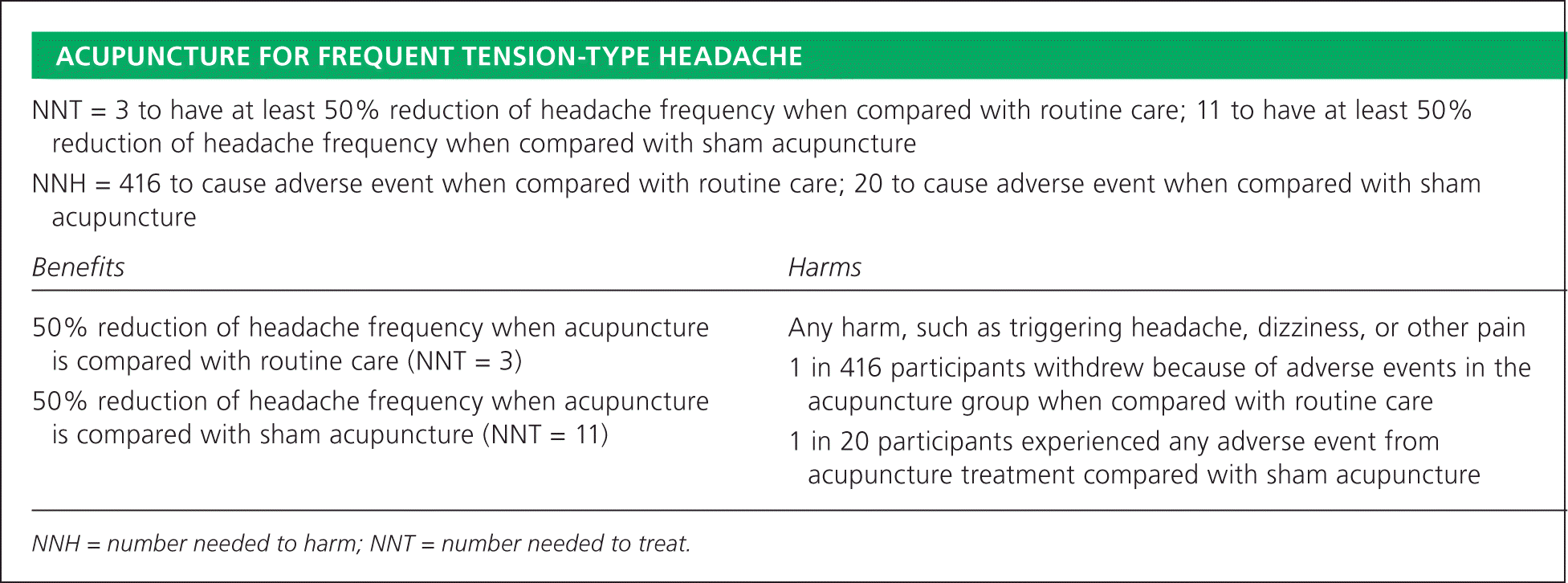
Am Fam Physician. 2016;94(3):online
Author disclosure: No relevant financial affiliations.


| NNT = 3 to have at least 50% reduction of headache frequency when compared with routine care; 11 to have at least 50% reduction of headache frequency when compared with sham acupuncture | |
|---|---|
| NNH = 416 to cause adverse event when compared with routine care; 20 to cause adverse event when compared with sham acupuncture | |
| Benefits | Harms |
| 50% reduction of headache frequency when acupuncture is compared with routine care (NNT = 3) | Any harm, such as triggering headache, dizziness, or other pain |
| 50% reduction of headache frequency when acupuncture is compared with sham acupuncture (NNT = 11) | 1 in 416 participants withdrew because of adverse events in the acupuncture group when compared with routine care |
| 1 in 20 participants experienced any adverse event from acupuncture treatment compared with sham acupuncture | |
Details for This Review
Study Population: Adults with episodic and/or chronic tension-type headaches
Efficacy End Points: At least 50% reduction of headache frequency after completion of treatment. This was usually three to four months after randomization (recommended as a primary outcome by the International Headache Society Clinical Trials Subcommittee).
Harm End Points: Any adverse event or participant dropping out because of an adverse effect
Narrative: Tension-type headache is the most common type of primary headache and causes more worldwide disability than migraine.1 Between 30% and 78% of the general population have experienced tension-type headache.2 Episodic tension-type headaches are defined as more than one but fewer than 15 days per month with a headache. This can evolve into chronic tension-type headaches in some patients, defined as 15 or more days per month with a headache.
A Cochrane review evaluated the available evidence regarding a course of acupuncture (at least six treatments) in the treatment of frequent tension-type headaches.3 The two largest trials included in this review compared acupuncture with routine care only (n = 1,265) or treatment of acute headaches only (n = 207).4 For those receiving acupuncture compared with routine care at three months, the number of patients achieving at least 50% reduction in headache frequency was 302 of 629 (48%) in the acupuncture group vs. 121 of 636 (19%) in the control group (relative risk [RR] = 2.52; 95% confidence interval [CI], 2.11 to 3.02; number needed to treat [NNT] = 3). For patients receiving acupuncture compared with treatment of acute headaches only, the same primary end point was achieved in 60 of 132 (45%) in the acupuncture group vs. three of 75 (4%) in the control group (RR = 11.36; 95% CI, 3.69 to 34.98; NNT = 2).
Acupuncture was also compared with sham acupuncture treatments. Pooled analysis of five trials (N = 391) shows that within three to four months after treatment, 205 of 391 participants (52%) achieved at least 50% reduction in headache frequency with acupuncture compared with 133 of 313 (43%) receiving sham treatments (RR = 1.27; 95% CI, 1.09 to 1.48; NNT = 11).
In comparing acupuncture with routine care, one of 132 patients dropped out because of adverse effects compared with none out of 75 in the routine care group (odds ratio [OR] = 1.72; 95% CI, 0.07 to 42.81; number needed to harm [NNH] = 416). These adverse effects included triggering of headache or other pain, hematoma, and dizziness. Of participants receiving acupuncture, one of 420 patients dropped out because of adverse effects compared with none out of 343 receiving sham treatments (OR = 1.45; 95% CI, 0.06 to 36.06; NNH = 420). In the acupuncture group, 29 of 174 patients (17%) vs. 12 of 103 (12%) in the sham group (OR = 1.26; 95% CI, 0.60 to 2.65; NNH = 20) reported any adverse effects.
Caveats: The large trials comparing acupuncture with routine care were not blinded, but the trial quality was otherwise high and deemed to have a low risk of bias. In addition, the randomized clinical trial assessing routine care only did not comment on the specific interventions included in this group. The headache baseline frequency and management in the control groups for these trials were notably different (the smaller study had a much more frequent baseline headache rate). The effect size estimates of the two trials also differed considerably. However, both showed a considerable and clinically important difference.
Also, the comparison of acupuncture to routine care showed an NNT of 3 with the primary end point of at least 50% reduction in headache frequency. However, the comparison of acupuncture to sham treatments corresponds to a slightly different NNT of 11. This suggests that although sham treatment is not the same as routine care, it could have underlying effects on the measured end points (such as intensity and length of headaches).
The number of participants dropping out because of adverse effects and the number of participants with adverse effects were reported only in the trials that included sham treatment groups. Others reported just the dropout rate because of adverse effects. Overall, these events were rare in any measured groups, which made these safety outcome estimates imprecise.
This series is coordinated by Dean A. Seehusen, MD, MPH, AFP Contributing Editor, and Daniel Runde, MD, from the NNT Group (theNNT.com).
A collection of Medicine by the Numbers published in AFP is available at https://www.aafp.org/afp/mbtn.
The opinions and assertions contained herein are the private views of the authors and are not to be construed as official or as reflecting the views of the U.S. Army, Navy, or Air Force Medical Departments or the U.S. Army, Navy, Air Force, or Public Health Service.
This review is available from the NNT Group at http://www.thennt.com/nnt/acupuncture-frequent-tension-type-headaches/.